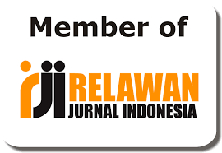Applying rasch model: Adversity quotient analysis of students in mathematics
Penerapan rasch model: Analisis adversity quotient siswa dalam matematika
Abstrak
This study aims to analyze the Adversity Quotient of students in mathematics using the Rasch Model. The population of this study is several Jakarta state high schools, with a total of 98 students in the 11th grade one of Jakarta State High Schools in the 2019/2020. This research is a quantitative descriptive study. With a non-test instrument Adversity Quotient questionnaire which consists of 39 statements with answers that use a Likert scale with 5 choices in the form of "strongly disagree", "disagree", "neutral", "agree", "strongly agree". Adversity Quotient is divided into categories by type of climbers, campers, quitters. The result of this study that climbers is the most dominant type that students have based on the research.
##plugins.generic.usageStats.downloads##
Referensi
Ardiyanti, D. (2017). Aplikasi Model Rasch pada Pengembangan Skala Efikasi Diri dalam Pengambilan Keputusan Karir Siswa. Jurnal Psikologi, 43(3), 248–263. https://doi.org/10.22146/jpsi.17801
Effendi, M., & Khairani, A. Z. (2015). Psychometric assessment on Adversity Quotient instrument (IKBAR) among polytechnic students using Rasch model. Proceedings of the International Conference on Education and Educational Technologies (EET 2015), 52–57. Diambil dari http://www.inase.org/library/2015/barcelona/EDU.pdf
Effendi, M., & Khairani, A. Z. (2016). Correlation between Adversity Quotient (AQ) with IQ, EQ and SQ Among Polytechnic Students Using Rasch Model. Indian Journal of Science and Technology, 9(47), 1–8. https://doi.org/10.17485/ijst/2015/v8i1/108695
Effendi, M., Khairani, A. Z., & Razak, N. A. (2015). The Influence of AQ on the Academic Achievement among Malaysian Polytechnic Students. International Education Studies, 8(6), 69–74. https://doi.org/10.5539/ies.v8n6p69
Ekayanti, A., & Nasyiithoh, H. K. (2018). Profile of Students’ Errors in Mathematical Proof Process Viewed from Adversity Quotient (AQ). Tadris: Jurnal Keguruan dan Ilmu Tarbiyah, 3(2), 155–166. https://doi.org/10.24042/tadris.v3i2.3109
Fadhila, S., Mudjiran, M., & Gistituati, N. (2019). The Contribution of Adversity Quotient to Learning Outcomes of Students in Middle School and the Counseling Services Implication. Journal of Educational and Learning Studies, 2(2), 65–70. https://doi.org/10.32698/0612
Febrian, F., & Fera, M. (2019). Kualitas Perangkat dan Keterampilan Mengajar Mahasiswa Pendidikan Matematika pada Mata Kuliah Micro Teaching Menggunakan Analisis Model Rasch. Jurnal Gantang, 4(1), 87–95. https://doi.org/10.31629/jg.v4i1.1065
Hanum, L. (2018). Differences in Student Adversity Intelligence by Gender. HONAI: International Journal for Educational, Social, Political & Cultural Studies, 1(2), 115–128.
Hastuti, T. D., Sari, D. R., & Riyadi. (2018). Student profile with high adversity quotient in math learning. Journal of Physics: Conference Series, 983(1). https://doi.org/10.1088/1742-6596/983/1/012131
Hayati, S., & Lailatussaadah. (2016). Validitas dan Reliabilitas Instrumen Pengetahuan Pembelajaran Aktif, Kreatif dan Menyenangkan (Pakem) Menggunakan Model Rasch. Didaktika, 16(2), 169–179.
Hidayat, W., Herdiman, I., Aripin, U., Yuliani, A., & Maya, R. (2018). Adversity Quotient (AQ) dan Penalaran Kreatif Matematis Mahasiswa Calon Guru. Jurnal Elemen, 4(2), 230–242. https://doi.org/10.29408/jel.v4i2.701
Hidayat, W., & Sariningsih, R. (2018). Kemampuan Pemecahan Masalah Matematis dan Adversity Quotient Siswa SMP Melalui Pembelajaran Open Ended. JNPM (Jurnal Nasional Pendidikan Matematika), 2(1), 109–118.
Hulaikah, M., Degeng, I. N. S., Sulton, & Murwani, F. D. (2020). The effect of experiential learning and adversity quotient on problem solving ability. International Journal of Instruction, 13(1), 869–884. https://doi.org/10.29333/iji.2020.13156a
Listiawati, N., & Sebayang, S. K. (2019). the Association Between Sociodemographic Factors and Teachers’ Guidance Towards Students’ Adversity Quotient. International Journal of Education, 11(2), 109–116. https://doi.org/10.17509/ije.v11i2.15341
Mursidi, A., & Soeharto. (2016). An Introduction: Evaluation of Quality Assurance for Higher Educational Institutions Using Rasch Model. Journal of Education, Teaching and Learning, 1(1), 1–6.
Nikam, V. B., & Uplane, M. M. (2013). Adversity Quotient and Defense Mechanism of Secondary School Students. Universal Journal of Educational Research, 1(4), 303–308. https://doi.org/10.13189/ujer.2013.010405
Pradika, I. D., Amin, S. M., & Khabibah, S. (2019). Relational Thinking in Problem Solving Mathematics based on Adversity Quotient and Visual Learning Style. International Journal of Trends in Mathematics Education Research, 2(4), 161–164.
Purwasih, R. (2019). Kemampuan Berpikir Kreatif Matematis Siswa SMP dalam Menyelesaikan Soal Pemecahan Masalah Ditinjau dari Adversity Quotient Tipe Climber. AKSIOMA: Jurnal Program Studi Pendidikan Matematika, 8(2), 323–332. https://doi.org/https://doi.org/10.24127/ajpm.v8i2.2118
Rashidi, M. N., Begum, R. A., Mokhtar, M., & Pereira, J. J. (2014). Pelaksanaan Analisis Data Menggunakan Model Pengukuran Rasch bagi Menentukan Wajaran Item. Journal of Advanced Research Design, 2(1), 1–9. Diambil dari http://www.akademiabaru.com/doc/ARDV2_N1_P1_9.pdf
Sahyar, & Fitri, R. Y. (2017). The Effect of Problem-Based Learning Model (PBL) and Adversity Quotient (AQ) on Problem-Solving Ability. American Journal of Educational Research, Vol. 5, 2017, Pages 179-183, 5(2), 179–183. https://doi.org/10.12691/EDUCATION-5-2-11
Samart, P., Piyakum, A., & Phusee-orn, S. (2017). Developing the Adversity Quotient of Mathayomsuksa 3 Students using the Integrated Group Counseling Program. Journal of Education, 11(4), 53–65.
Sari, C. K., Sutopo, S., & Aryuna, D. R. (2016). The Profile of Students’ Thinking in Solving Mathematics Problems Based on Adversity Quotient. JRAMathEdu (Journal of Research and Advances in Mathematics Education), 1(1), 36–48. https://doi.org/10.23917/jramathedu.v1i1.1784
Shen, C. (2014). The Relative Study of Gender Roles, and Job Stress and Adversity Quotient. The Journal of Global Business Management, ISSN: 1817-3179, 10(1), 19–32.
Soeharto, S., & Rosmaiyadi, R. (2018). The Analysis of students’ higher order thinking skills (HOTS) in Wave and Optics Using IRT with Winstep Software. Journal of Educational Science and Technology (EST), 4(3), 145–150. https://doi.org/10.26858/est.v1i1.7001
Stoltz, P. G. (1997). Adversity Quotient: Turning Obstacles into Opportunities. Canada: John Wiley & Sons, Inc.
Sumintono, B., & Widhiarso, W. (2014). Aplikasi Model Rasch Untuk Penelitian Ilmu-ilmu Sosial (Revisi). Cimahi: Trim Komunikata Publishing House.
Suryadi, B., & Santoso, T. I. (2017). Self-Efficacy, Adversity Quotient, and Students’ Achievement in Mathematics. International Education Studies, 10(10), 12–19. https://doi.org/10.5539/ies.v10n10p12
Yanti, A. P., & Syazali, M. (2016). Analisis Proses Berpikir siswa dalam Memecahkan Masalah Matematika Berdasarkan Langkah-langkah Bransford dan Stein Ditinjau dari Adversity Quotient. Al-Jabar: Jurnal Pendidikan Matematika, 7(1), 63–74.





















